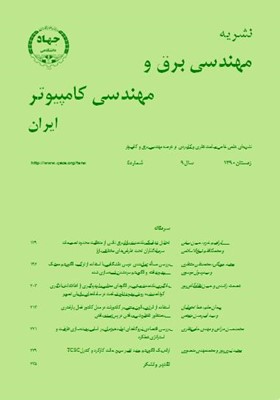بررسی اقتصادی نیروگاههای تولید همزمان بر اساس بهینهسازی ظرفیت و استراتژی عملکرد
محورهای موضوعی : مهندسی برق و کامپیوترمحمدحسن مرادی 1 * , مهدی حاجینظری 2
1 - دانشگاه بوعلی سینا همدان
2 - دانشگاه بوعلی سینا همدان
کلید واژه: تولید همزمان برق و حرارت (CHP) ارزش خالص فعلی (NPV) الگوریتم بهینهسازی اجتماع پرندگان (PSO),
چکیده مقاله :
تولید همزمان برق و حرارت (CHP) با استفاده از یک نوع سوخت ورودی، صرفهجویی انرژی قابل توجهی را ممکن ساخته و در بسیاری از موارد با توجه به بازده انرژی بالا، کاهش انتشار آلودگی و افزایش قابلیت اطمینان، جایگزینی کلیدی برای تولید مجزای انرژی حرارتی و الکتریکی شناخته میشود. با این حال وجود یک ارزیابی صحیح در جهت بررسی توجیهپذیری اقتصادی سرمایهگذاری در این نیروگاهها با توجه به شرایط مختلف از جمله نوع و حجم تقاضای انرژی محل مصرف و همچنین مشخصات پارامترهای بهرهبرداری ضروری به نظر میرسد. از این رو در اين مطالعه يک چهارچوب بهينهسازي اقتصادی بهمنظور ارزيابي سرمايهگذاري در احداث واحد توليد همزمان ارائه میگردد که در آن یک استراتژی بهینه با توجه به مدل عملکرد نیروگاه برای کاهش هزینههای بهرهبرداری و همچنین کاهش انتشار آلودگی زیستمحیطی پیشنهاد میگردد. برای کاهش هزینههای مربوط به تأمین تقاضای انرژی در هر ساعت (تعیین استراتژی عملکرد) از برنامهریزی خطی استفاده میگردد و در ادامه، استراتژی مورد نظر به کمک الگوریتم بهینهسازی اجتماع پرندگان (PSO)، برای تعیین ظرفیت بهینه CHP و بویلر کمکی، تا دستیابی به ماکزیمم مقدار ارزش خالص فعلی (NPV) از مقادیر مورد انتظار سرمایهگذاری بهکار میرود. در نهايت کارایی روش پیشنهادی با آنالیز تصمیم احداث يک نیروگاه CHP براي یک بيمارستان نمونه ارائه میگردد.
An optimization method has been developed to determine the optimal capacities for the CHP and boiler such that thermal and electrical energy demands can be satisfied with high cost efficiency. The proposed method offers an operational strategy in order to determine the optimum value for boiler and CHP capacities which maximize an objective function based on the net present value (NPV). The reduction in operational strategy expenses arising from the monetary cost of the credit attainable by air pollution reduction is also taken into account in evaluation of the objective function. The optimal value for boiler and CHP capacities and the resulting projection for the optimal value of the objective function are derived using a hybrid optimization method involving the particle swarm optimization (PSO) and the linear programming algorithms. The viability of the proposed method is demonstrated by analyzing the decision to construct a CHP system for a typical hospital.
[1] D. W. Wu and R. Z. Wang, "Combined cooling, heating, and power: a review," Prog. Energy Combust. Sci., vol. 32, no. 5-6, pp. 459-495, Sep./Nov. 2006.
[2] G. Chicco and P. Mancarella, "Distributed multi - generation: a comprehensive view," Renew. Sustain. Energy Rev, vol. 13, no. 3, pp. 535-551, Apr. 2009.
[3] H. S. Joel and S. C. Augusto, "Trigeneration: an alternative for energy savings," Appl. Energy, vol. 76, no. 1-3, pp. 219-227, Sep./Nov. 2003.
[4] M. Rabinowitz, "Power system of future," IEEE Power Engineering Review, pt 4, vol. 4, no. 8, pp. 4-9, Aug. 2000.
[5] A. A. Rentizelas and I. P. Tatsiopoulos, "Locating a bioenergy facility using a hybrid optimization method," Int. J. Prod. Econ., vol. 123, no. 1, pp. 196-209, Jan. 2010.
[6] A. Piacentino and F. Cardona, "On thermoeconomics of energy systems at variable load conditions: integrated optimization of plant design and operation," Energy Convers. Manage., vol. 48, no. 8, pp. 2341-2355, Aug. 2007.
[7] B. Zhang and W. Long, "An optimal sizing method for cogeneration plants," Energy Build., vol. 38, no. 3, pp. 189-195, Mar. 2006.
[8] X. Q. Kong, R. Z. Wang, and X. H. Huang, "Energy optimization model for a CCHP system with available gas turbines," Appl. Therm. En.g, vol. 25, no. 2-3, pp. 377-391, Feb. 2005.
[9] A. Rong and R. Lahdelma, "An efficient linear programming model and optimization algorithm for trigeneration," Appl. Energy, vol. 82, no. 1, pp. 40-63, Sep. 2005.
[10] A. Rong, H. Hakonen, and R. Lahdelma, "An efficient linear model and optimisation algorithm for multi - site combined heat and power production," Eur. J. Oper. Re., vol. 168, no. 2, pp. 612-632, Jan. 2006.
[11] E. Thorin, H. Brand, and C. Weber, "Long - term optimization of cogeneration systems in a competitive market environment," Appl. Energy, vol. 81, no. 2, pp. 152-169, Jun. 2005.
[12] A. Rong, R. Lahdelma, P. B. Luh, "Lagrangian relaxation based algorithm for trigeneration planning with storages," Eur. J. Oper. Res., vol. 188, no. 1, pp. 240-257, Jul. 2008.
[13] M. Sakawa, K. Kato, and S. Ushiro, "Operational planning of district heating and cooling plants through genetic algorithms for mixed 0-1 linear programming," Eur. J. Oper. Res., vol. 137, no. 3, pp. 677-687, Mar. 2002.
[14] M. V. Biezma and J. R. SanCristobal, "Investment criteria for the selection of cogeneration plants - a state of the art review," Appl. Therm. Eng., vol. 26, no. 5-6, pp. 583-588, Apr. 2006.
[15] G. Celli, E. Ghiani, S. Mocci, and F. Pilo, "A multiobjective evolutionary algorithm for the sizing and siting of distributed generation," IEEE Trans. on Power Systems, vol. 20, no. 2, pp. 750-757, May 2005.
[16] E. Cardona and A. Piacentino, "A methodology for sizing a trigeneration plant in mediterranean areas," Appl. Therm. Eng., vol. 23, no. 13, pp. 1665-1680, Sep. 2003.
[17] G. Chicco and P. Mancarella, "Assessment of the greenhouse gas emissions from cogeneration and trigeneration systems, part I: models and indicators," Energy, vol. 33, no. 3, pp. 410-417, Mar. 2008.
[18] Report by Energy and Environmental Analysis, Technology Characterization: Gas Turbines, Dec. 2008.
[19] K. M. Maribu, R. M. Firestone, C. Marnay, and A. S. Siddiqui, "Distributed energy resources market diffusion model," Energy Policy, vol. 35, no. 9, pp. 4471-4484, Sep. 2007.
[20] Action Energy, CHP Sizer Version 2, The Carbon Trust: London, UK; 2004.

